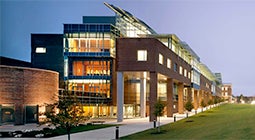French Pressure Cell Disruptor
The “French Pressure Cell” disrupts (“breaks”) the cells of microorganisms by elevating the cell suspension to a high pressure and then allowing it to escape back to ambient pressure through a small orifice. An alternative to the French Pressure Cell is the Microfluidizer, which operates on a similar principle but is suitable for much larger volumes.
The device was invented by an American scientist, Charles Stacey French, at the Rockefeller Institute, and is named for him. The conditions of cell disruption can be carefully controlled by adjusting the applied pressure. It is most useful for small volumes of cell suspension (less than 35mL) or when the cells of microorganisms need to be broken in a very controlled way; for example, it can be used to prepare inside-out sub-bacterial vesicles from intact cells.
The Microbiology Core Facility has two “cells” for this device: A standard-volume cell that holds approximately 35mL, and and a“mini” cell that holds approximately 7mL.
Since the French Pressure Cell does not always shear the DNA released when cells break, it is recommended to add DNAase (and Mg2+) prior to processing to avoid high viscosity conditions
| RPI Users | External Nonprofit | External Industry | External Industry Partners | |
|---|---|---|---|---|
| Personnel Time | $77 | $127 | $253 | $228 |
Effective August 1, 2025 through July 31, 2026. Rates are hourly unless specified otherwise and are subject to change without further notice.
Required Acknowledgement and Authorship
Please acknowledge the CBIS Core Facilities in all publications and grant applications where our equipment and/or personnel have facilitated the work. These acknowledgements are very important because documenting our contributions helps to ensure that the resources of the Core Facilities are sustainable.
- Equipment: If you used Core Facility equipment, please note this in the Materials and Methods. e.g., Thermogravimetric analysis was carried out using a TA Instruments TGA-Q50 (Rensselaer CBIS Analytical Biochemistry Core Facility).
- Personnel: Please consider including CBIS personnel as co-authors on your publications when they have made a significant intellectual contribution to the research. Include CBIS Core Facility directors or staff as co-PI or co-investigators in grant applications when they provide a significant contribution to the grant proposal and scientific/intellectual leadership for the proposed work. Please follow these guidelines: ABRF Recommended Guidelines for Authorship on Manuscripts. Also, our Core Facility personnel always appreciate when they are mentioned in the Acknowledgements section of publications.
- Required Funding Authorization Form: Rensselaer researchers must fill out the CBIS Cores Authorization Form (PDF) to use the CBIS Core Facilities.
